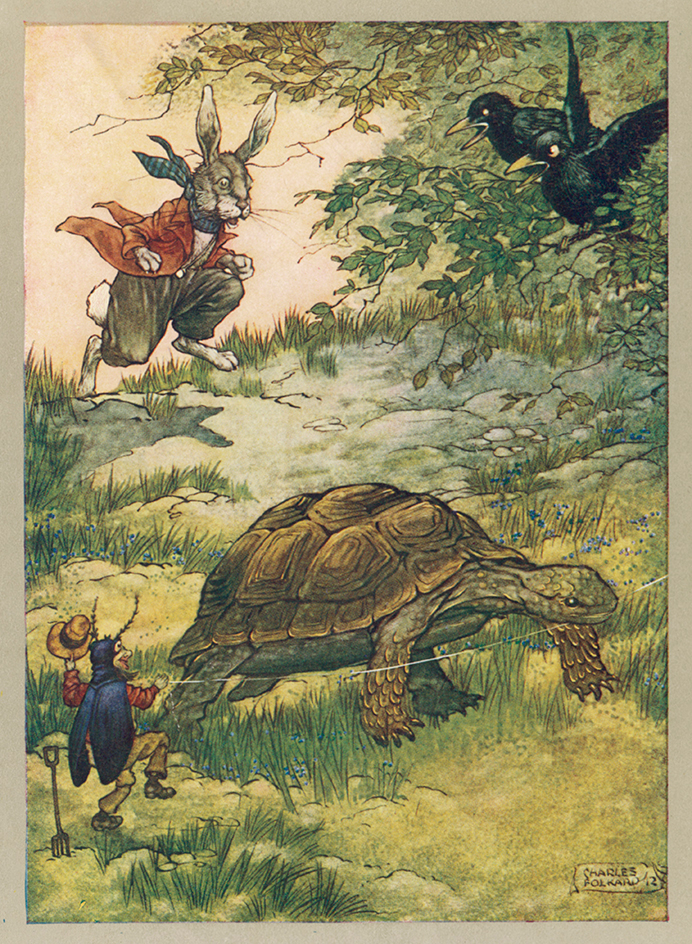Fable is a brief fictitious story that teaches a moral. In most fables, one or more of the characters is an animal, plant, or thing that talks and acts like a person. A fable may be told in prose or in verse. In many fables, the moral is told at the end in the form of a proverb.

Famous fables include “The Fox and the Grapes,” “The City Mouse and the Country Mouse,” and “The Wolf in Sheep’s Clothing.” These tales have been told and retold for more than 2,000 years. They remain popular because they illustrate truths that almost anyone can recognize. In “The Fox and the Grapes,” for example, a fox decides that some grapes growing too high for him to reach are probably sour anyway. A person who hears the tale recognizes the fox’s attitude as a common human failing. The moral of the fable—that people often express a dislike for what they cannot have—is summed up in the expression “sour grapes.”
Nearly all ancient peoples invented folk tales in which animals had human traits. The fox was often pictured as sly, and the owl as wise. In time, people began to tell the stories to teach morals. The tales thus became fables.
Most of the fables that are popular in Western countries can be traced back to ancient Greece and India. The majority of the Greek fables are credited to Aesop, a Greek slave who lived about 600 B.C. Aesop had a reputation for telling wise, witty tales about animals, but scholars know little else about him. The fables known as “Aesop’s fables” probably came from several ancient sources. Some of the stories originated in India.
The fables of the people of India were influenced by their belief that after death, human beings might be reborn as animals. Indian storytellers made up many tales of such rebirths and used them to teach a variety of morals. Some of these fables had reached the West by the start of the Christian era and were included in early collections of Aesop’s fables. During the 200’s B.C. or after, the Indians collected their best-known fables in a work called the Panchatantra.

Through the centuries, many writers have retold the ancient fables. The most famous such writer was Jean de La Fontaine, a French poet of the 1600’s. La Fontaine retold Aesop’s fables in elegant verse and expanded their meanings. Fables had always made fun of human follies, but La Fontaine turned such satire into biting social criticism.
In La Fontaine’s version of “The Fox and the Crow,” for example, a fox robs a crow of some cheese by telling him what a fine singing voice he must have. As the flattered crow opens his mouth to caw, the cheese drops from his beak. Earlier versions of the fable poked fun at the crow for being fooled by the fox’s flattery. La Fontaine’s version includes the trickery of the fox and ends with a thoughtful moral: “Every flatterer lives at the expense of his listeners.” La Fontaine wrote his fables mainly for adults, but they have long been favorites of French children.
La Fontaine has had many imitators. One of the most successful was Ivan Krylov, a Russian poet of the early 1800’s. Krylov translated La Fontaine’s fables into Russian and also wrote many of his own. Krylov intended his stories mainly for adults. But they have become the most popular children’s stories in Russia.
During the 1900’s, writers continued to develop the fable as a literary form. The Irish novelist James Joyce wove “The Fox and the Grapes” and “The Ant and the Grasshopper” into his Finnegans Wake. The fables help create the mood of fantasy that characterizes this novel. The American humorist James Thurber revived the fable as a form of social criticism. His fables are noted for their stinging portrayal of the anxieties of modern life.
See also Aesop’s fables; Allegory; Folklore; La Fontaine, Jean de; Literature for children (Traditional literature).
